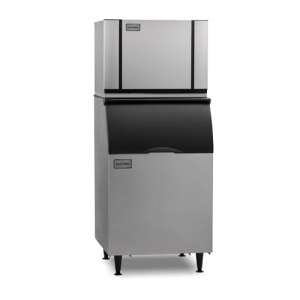Commercial ice machines can be a major purchase. Choosing the right size ice maker and bin is important to avoid ice shortages and the expense of purchasing additional bagged ice. A well-maintained commercial ice maker has a life expectancy of more than 10 years. By calculating your ice requirements up front, you can avoid the need for an early upgrade or additional machine. Each type of operation uses a different amount of ice, and the math is never exact, but with some reasonable guidelines and a recommended margin of error, you can ensure a continuous supply of quality ice in your restaurant or foodservice operation. A Kitchen Spot Expert can help you with your calculations and buying decision.

Ice Makers – Selecting a Size
Ice makers are typically specified by pounds of ice per day. So for instance, a 500 lb machine will make 500 lbs of ice over a 24 hour period, given an ambient air temperature of about 70°F and an incoming water temperature of about 50°F. If the ice machine is located in a 90° kitchen or bakery, and the incoming water temperature is closer to 70°, then you can expect less ice production by as much as 15% or more. Ice machine manufacturers such as Ice-O-Matic, Scotsman Ice Systems, and Manitowoc Ice all publish output for various models at different ambient temperatures. Machines range in output from 50 to well over 1200 lbs of ice per day.
In general, it’s better to have a surplus of ice than a shortage of ice. A good rule of thumb is to select an ice maker that produces about 20% more ice than your daily needs. So if your operation needs 500 pounds of ice per day, purchase a 600 lb ice maker. Once your needs exceed 1000 lbs per day, then 10% additional output should suffice. This will provide you with surplus in the event of a sudden rush of business, a temporary power outage, an unforeseen rise in ambient temperatures, or other eventualities.
Calculate your daily needs based on your peak business days. Some operations need more ice during Friday and Saturday nights for bar and dinner business. Some operations need more ice in summer when heat and cold drink consumption rises. Some operators need more ice in December when holiday banquets and parties are being booked every night of the week. When calculating ice needs, use numbers that are based on your busiest days, not typical days.
 Commercial Ice Bins – Sizing
Commercial Ice Bins – Sizing
Many ice machines come with built in bins. Many do not. Ice bins are typically specified by the maximum pounds of ice they can hold when leveled off at the top. Ice makers typically feature an automatic shut off switch that prevents the bin from overfilling. Ice that piles up into a peak can trigger the automatic shut-off even though there is technically more storage space in the bin. Expect your bin to accumulate about 10 to 20% less than what is actually specified. You can compensate for this, and allow room to accumulate some extra ice, by selecting a bin that holds 10 to 20% more ice than your ice maker produces. For example, you might select a 700 lb ice bin to go with your 600 lb ice maker.
While a little surplus of ice is helpful, ice bins as big as twice the size of the ice maker are not advisable. Unused ice simply melts away and goes down the drain. That is a waste of water and energy. Additionally, bins that are too big can end up with a frozen block of old, stagnant ice at the bottom, a condition that can promote algae growth. On the other extreme, bins that are too small will not allow you to benefit from the full production capacity of your ice maker. So, a bin that holds about 10 to 20% more than your ice maker produces is a good rule of thumb.
An exception to this rule is when ice is only used one or two days a week. A church, event center, or music venue, for example, may use 500 lbs of ice on weekends, but none during the week. In those instances, it might make sense to have a 200 lb ice maker atop a 700 lb bin because the bin has several days to refill between uses and there is no extended period of time for ice at the bottom of the bin to stagnate. Your customer will save money on the initial purchase price of the smaller unit.
Pounds Of Ice Per Day
Different types of operations use different amounts of ice. The chart below shows some universally accepted guidelines you can use to calculate your daily needs.
Type of Operation / Volume of Ice Needed
(Add 20% for Safe Margin of Error)

